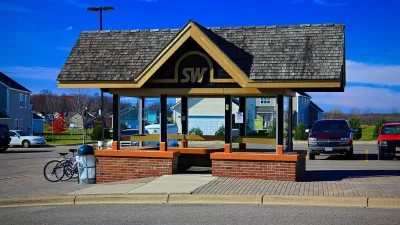A recent opinion piece in The Wall Street Journal on the reasons why "Americans don't want to live in Ray LaHood's car-free utopia" is garnering a lot of attention in the planning and transportation worlds.
In the opinion piece, the Journal's editors slam the ongoing struggle to complete a new multi-year transportation bill as bereft of any "new thinking." They point to estimates that "traffic gridlock costs motorists more than $100 billion a year in delays and wasted gas" as evidence of "inefficient transportation spending" in which 35 cents of every gas tax dollar is "intercepted by the public transit lobby and Congressional earmarkers." According the the editors, who clearly aren't traffic engineers, "This congestion could be alleviated by building more highway lanes where they are most needed and using market-based pricing-such as tolls-for using roads during peak travel times."
In attacking Transportation Secretary Ray LaHood's "strange 'livability' agenda" wherein people can actually complete a daily chore or two without getting in an automobile, they conclude that, "If Congress really wants to enhance the livability of cities and suburbs, it will pass a highway bill that builds more roads."
It's hard to know where to begin in refuting the naive comments made in the article, but Janet Kavinoky at the U.S. Chamber of Commerce's Free Enterprise blog, of all places, takes a shot. Citing their strong belief that "transit is a critical means of addressing congestion and driving economic development in many areas around the country", Kavinoky, speaking on behalf of the Chamber, argues that "the federal government plays an important and necessary role in infrastructure investment."
FULL STORY: Why Your Highway Has Potholes

Alabama: Trump Terminates Settlements for Black Communities Harmed By Raw Sewage
Trump deemed the landmark civil rights agreement “illegal DEI and environmental justice policy.”

Planetizen Federal Action Tracker
A weekly monitor of how Trump’s orders and actions are impacting planners and planning in America.

Why Should We Subsidize Public Transportation?
Many public transit agencies face financial stress due to rising costs, declining fare revenue, and declining subsidies. Transit advocates must provide a strong business case for increasing public transit funding.

Understanding Road Diets
An explainer from Momentum highlights the advantages of reducing vehicle lanes in favor of more bike, transit, and pedestrian infrastructure.

New California Law Regulates Warehouse Pollution
A new law tightens building and emissions regulations for large distribution warehouses to mitigate air pollution and traffic in surrounding communities.

Phoenix Announces Opening Date for Light Rail Extension
The South Central extension will connect South Phoenix to downtown and other major hubs starting on June 7.
Urban Design for Planners 1: Software Tools
This six-course series explores essential urban design concepts using open source software and equips planners with the tools they need to participate fully in the urban design process.
Planning for Universal Design
Learn the tools for implementing Universal Design in planning regulations.
Caltrans
Smith Gee Studio
Institute for Housing and Urban Development Studies (IHS)
City of Grandview
Harvard GSD Executive Education
Toledo-Lucas County Plan Commissions
Salt Lake City
NYU Wagner Graduate School of Public Service





























